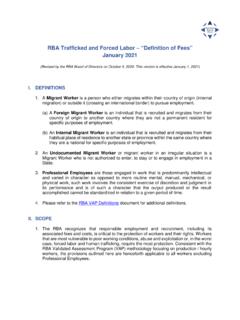Transcription of F A C T S H E E T 9 R A C I A L I Z E D P O V E R T Y I N ...
1 FACT SHEET# 9. RACIALIZED POVERTY IN HOUSING & HOMELESSNESS. How are racialized people disadvantaged in housing and homelessness? Inadequate Housing: Just over 50% of people of colour households in Canada live in homes which An Indigenous Focus are not affordable (leading to homelessness) and inadequate (require repair or maintenance) and unsuitable (overcrowded, among other issues). In 2011, a federal evaluation of First Nations housing This compares to 28% of non-racialized stated that per cent of on-reserve households households. required major renovations, compared to only 7 per Affordable housing isn't cent of non-Indigenous households. Mould, bug being built for people of infestations, inadequate heating and contaminated colour and newcomers water are just some of the issues. with larger families - with In 2016, the Toronto Star reported that Attawapiskat "Inclusionary Zoning" now First Nation in Ontario has about 2,100 residents but undermined by weak only 340 homes. This means that more than one provincial legislation.
2 Family often reside in the same household. Some houses hold up to 13 people. Over-representation: Primary destinations for 28-34% of the shelter population is Indigenous. immigrants and refugees, larger urban centres in Indigenous people are overrepresented amongst Ontario are also preferred homes for communities the homeless population in virtually all urban of colour - with all significantly over-represented in centres in Canada. poorer quality housing. According to a national report, those who reported Housing Cost: One study found that an Indigenous identity were more than twice as most immigrants were spending more than 50% likely (18%) to have experienced hidden of their income on housing with 15% spending homelessness as their non-Indigenous counterparts 75% or more of their income on housing. (8%). Discrimination: In addition to poor housing conditions, Indigenous Peoples, peoples of colour Hidden homelessness is defined as people and immigrants face discrimination on the basis who live temporarily with others but without of source of income, credit history, access to guarantee of continued residency or guarantors and references, racial identity, immediate prospects for accessing permanent immigration status, gender and age.
3 Housing. This describes people staying with Immigrants: A recent study found 80% of relatives, friends, neighbours or strangers immigrants live in rental housing. Immigrant because they have no other option. women are at higher risk of housing insecurity;. 50% of recent immigrant female lone parents are in core housing need. Refugees: Over half of refugees and asylum seekers stayed in a shelter at some point, which indicates that this group is at higher risk of homelessness. March 2019. Being on welfare, or being homeless basically, you have no references, and most landlords don't like I don't have [first and last months' rent].. and secondly, it's my colour, some landlord don't like that. I went to this lady and she said she has a problem with Black people. Canada's "Red-Lining": Racialized groups are often In 2017, the average rent forced to accept housing that is unsafe, unhealthy, in Ontario for a one- substandard and in neighbourhoods that have high bedroom apartment was crime rates and low average incomes.
4 $994. The hourly wage Hidden Homelessness: In addition to the visibly needed for this rent to be homeless, 450,000 900,000 Canadians represent affordable would be $19. the hidden' homeless. Race: Poverty and minority race are key factors that can lead to homelessness. Racialized people The average rent in experience disproportionately higher levels of Toronto for a one- homelessness and poor housing. Immigrants and bedroom apartment was refugees in Ontario are at risk for homelessness due $1,132 in 2016. The hourly to poverty, discrimination, cuts to social programs, wage needed for this rent lack of housing services, and lack of information to be affordable (30% of about rights. income or less) would be $ Quick Notes Even after an increase in When we refer to peoples of colour we speak minimum wage, housing of Canadians of non-European background or will remain unaffordable heritage - both people of colour who are for those making less than Canadian-born as well as those who are born $19 an hour.
5 Elsewhere. When we refer to Indigenous Peoples, we Reforms introduced by the Ontario Government speak of First Nations, Inuit, and M tis in May 2017 called for minimum wage to be persons. increased to $15 per hour by January 2019. In Toronto, 62% of all persons living in Implementing this increase is critical to helping poverty are from racialized groups. racialized communities access affordable housing. 52% of Canada's racialized people living in poverty reside in Ontario. Households that fall below Canada's low what's being done? income cut-off (LICO) or low income measure (LIM), spend a much larger percent Zhaawnong Gamik, Nishnawbe Homes provides for of their income on basic necessities like food the many single Indigenous Peoples coming to Toronto and shelter than the average family; this is for education or job opportunities. Nishnawbe Homes how we measure poverty. offers affordable housing that connects them to the Systemic racism is often caused by hidden community and reflects First Nations culture.
6 Institutional biases in policies, practices and processes that privilege or disadvantage Advocacy for Centre for Tenants Ontario (ACTO) works certain groups of people. It can be the result for the advancement of human rights and justice in of doing things the way they have always housing for low- income Ontarians through legal advice been done without considering how they & representation, law reform, community organizing, affect particular groups differently. training and education. March 2019.
